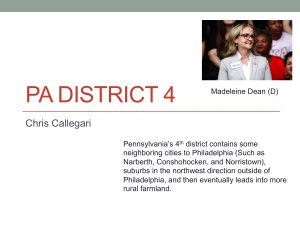
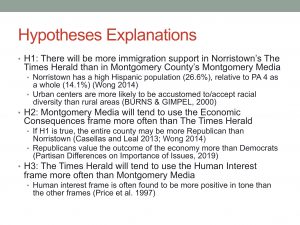
I have three hypotheses concerning immigration support, population and the media based on the data I collected. My first hypothesis (H1) is that there will be more immigration support in The Times Herald than in Montgomery Media—both newspapers within PA district 4. The Times Herald circulation base is centered in Norristown, while Montgomery Media circulation focus is all of Montgomery County (The largest county covered by PA 4). I argue the comparatively high Hispanic population in Norristown (26.6%) vs. PA 4 as a whole (14.1%) will lead to The Times Herald having greater pro-immigration support. Areas with higher percentage of Hispanic populations are often found to have greater immigration support (Wong 2014). In addition to having a higher percentage Hispanic population that would predict increased immigration support, urban centers in general are found to be more accepting of racial diversity than rural areas (BURNS & GIMPEL, 2000). Because Norristown is much more urban than some of the farmland in other areas of PA 4, I postulate that there will be more immigration support and racial acceptance. Both of these factors will lead to increased immigration support in a newspaper from Norristown compared to one from all of Montgomery County. All of these claims are based under the assumption that the local newspaper will mimic the local population’s opinion, which, although plausible, may not necessarily be true.
My second hypothesis (H2) is that Montgomery Media will tend to use the Economic Consequences frame more often than The Times Herald. If H1 is found to be true, and since partisanship is the greatest predictor of immigration support (Casellas and Leal 2013; Wong 2014), then residents of the entire county may be more conservative/Republican than those of Norristown. Republicans were found to value the outcome of the economy more than Democrats (Partisan Differences on Importance of Issues, 2019), so Montgomery County will give the economy more weight. Again, this is based on the assumption that local newspapers represent the views of the residents in that region.
The third hypothesis (H3) is that The Times Herald will use the human interest frame more often than Montgomery Media. If The Times Herald is found to be more supportive of immigration than Montgomery Media from H1, they will be more likely to discuss immigration in a positive tone. The human interest frame is often found to be more positive in tone than the other frames (Price et al. 1997). Based on this, The Times Herald should use the human interest frame more often than Montgomery Media.
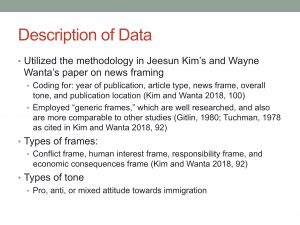
I utilized the methodology in Jeesun Kim’s and Wayne Wanta’s paper on news framing (Kim and Wanta, 2018). They coded for year of publication, article type, news frame, overall tone, and publication location (Kim and Wanta 2018, 100). Their methodology was utilized specifically because they employed “generic frames,” which are well researched, and also are more comparable to other studies (e.g., Gitlin, 1980; Tuchman, 1978 as cited in Kim and Wanta 2018, 92). In the coding category of news frame, Kim and Wanta looked for four major frames: conflict frame, human interest frame, responsibility frame, and economic consequences frame (Kim and Wanta 2018, 92). Each of the frames is defined as follows (Kim and Wanta 2018, 93-94):
“Conflict frames focus on conflict between individuals, groups, or institutions (Neuman et al., 1992) in order to capture audience interest” (Semetko & Valkenburg, 2000 as cited in Kim and Wanta 2018, 92).
“The Human Interest Frame uses an individual’s story or an emotional angle to describe an issue, event, or problem” (Valkenburg, Semetko, & de Vreese, 1999 as cited in Kim and Wanta 2018, 93).
“Responsibility Frame describes an issue or problem in a way to attribute responsibility for causing or solving a problem to the government or to an individual or to a group” (Iyengar, 1987; Valkenburg et al., 1999 as cited in Kim and Wanta 2018, 93).
“The Economic Consequences Frame emphasizes the economic effects of actions or events on individuals, groups, or nations” (de Vreese, Peter, & Semetko, 2001; Valkenburg et al., 1999 as cited in Kim and Wanta 2018, 94).
In addition to the amount of reference, I modified Kim and Wanta’s (2018) methodology by assigning number values to article tone. A “1” value means that the article is pro-immigration, a “2” value means the article is neutral or mixed, and a “3” value means the article is anti-immigration.
All of the data collected followed the specific guidelines given for the “Media Content Analysis” assignment. The article dates were between Dec 11, 2018 and Jan 31, 2019. The keywords used were: “Immigration,” “Immigrant,” “Border,” “Wall,” “Undocumented,” “shutdown,” and “security.” The articles that contained more than one term were only counted once. As mentioned before, both the focus and tone were analyzed.
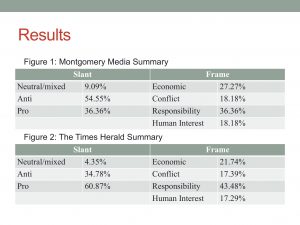
After doing the proposed media analysis following the methodology and guidelines, the results were mostly expected. Montgomery Media had more neutral and anti-immigrant articles (9.09% and 54.55% respectively) than The Times Herald (4.35% and 34.78% respectively). The Times Herald has a more pro-immigration stance (60.87%) compared to Montgomery Media (36.36%). Montgomery Media also had more economic (27.27%), conflict (18.18%), and human interest frames (18.18%) compared to The Times Herald (21.74%, 17.39%, and 17.29% respectively). The only frame that occurred more in The Times Herald was responsibility (43.48%), with Montgomery Media only using it 36.36% of the time. There were 11 articles examined from Montgomery Media and 23 articles examined from The Times Herald that matched the keyword search terms outlined for the assignment.
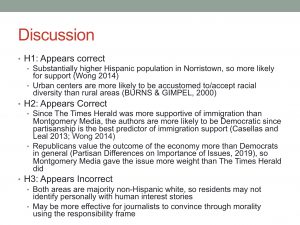
After examining the results, H1 appears correct. The Times Herald had less anti-immigration sentiment (19.77pp margin), and more pro-immigration sentiment (24.51pp margin) than Montgomery Media. As mentioned previously, there is a substantially higher Hispanic population in Norristown (26.6%) than in the entirety of PA 4 (14.1%). An increased Hispanic population is associated with increased immigration support, so the results logically follow (Wong 2014). Additionally, urban centers are more likely to accept racial diversity than rural areas (BURNS & GIMPEL, 2000). Because Norristown is much more urban than all of Montgomery county, this finding is also in line with the media analysis data seen here.
H2 also appears to be correct because Montgomery Media used the Economic Consequences frame more often than The Times Herald (5.53pp margin). Partisanship is often the best predictor of immigration support (Casellas and Leal 2013; Wong 2014). Because The Times Herald was more supportive of immigration, it follows that they are more likely to be Democratic than Montgomery Media. In general, Republicans value the outcome of the economy more than Democrats (Partisan Differences on Importance of Issues, 2019). If Montgomery Media is more likely to be closer to Republican than The Times Herald is, they are also more likely to value the outcome of the economy more. This theory seems to be supported by the evidence gathered.
H3 appears to be incorrect. Although they were close to equal, The Times Herald used the human interest frame less often (.89pp margin) than Montgomery Media. One possible reason for this incorrect hypothesis is that both regions are majority non-Hispanic white. Because of this, they may not have a strong personal identity with the individual story of a particular Hispanic immigrant. Although these stories may be convincing to some, lacking a personal connection with the subject could make for a less convincing argument. The authors could have taken this into account and instead utilized the responsibility frame which The Times Herald used more frequently than Montgomery Media (7.12pp margin). The responsibility frame could focus on a more generally applicable and relatable argument for immigration—taking public good and general moral responsibility into account. Although this is one possible causal explanation, there is no definitive singular reason as to why The Times Herald and Montgomery Media did not fit within the predictive literature.
There are also ways to improve this experiment in the future. Because of the sample size difference (n=11 for Montgomery Media and n=23 for The Times Herald) we should cover a wider time period selection to see if the observed trends remain. Although H1 and H2 were both found to be true, the results would be strengthened utilizing a longer term approach to media analysis with both larger n values and also information on how the data trends over time.